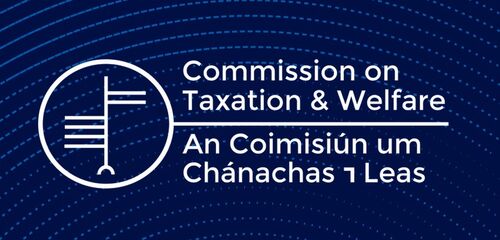On September 14th 2022, the report from Commission on Taxation and Welfare (COTW) was published. Amongst the key messages in the Executive Summary are that:
- The adequacy of social welfare rates is central to poverty reduction. Regular benchmarking exercises for working-age payments should be undertaken, which would set multi-annual targets for progress in rates.
- Working-age payments should be reformed to move towards a working-age assistance payment available to all households. The existing system of child income support should be enhanced with a second level of child income support, in addition to Child Benefit, for low-income households. These reforms could usefully be progressed in tandem. (p xxv)
The report contains eighteen chapters, and of particular interest to the INOU are chapters ten, eleven and twelve which focus on labour markets and social protection systems; promoting employment; and inclusive and integrated social protection. This article will give readers a flavour of the Commission’s findings and recommendations.
Chapter 10: Labour Markets and Social Protection Systems
In this chapter the COTW note “A coherent approach to the design of the taxation and welfare systems will encourage labour force entry, encourage people to take up work, support people in work who are on low pay and facilitate progression from lower to higher earnings.” (p226)
The report also states that “In economic terms, social protection plays a major role in smoothing incomes and supporting aggregate demand for goods and services after an employment shock. In this way, it acts as an automatic stabiliser, protecting and enhancing human capital and productivity, contributing to inclusive growth and facilitating structural change.” (p227)
Later on this chapter the COTW note that “Over the past decade, there has been a clear policy of developing the PES in line with international thinking that, for people of working age, social protection systems should be more ‘active’ i.e. provide support to jobseekers finding employment, as well as providing benefits.” (p231)
Chapter 11: Promoting Employment
Section 11.3.5 is titled The Public Employment Service and in this section the COTW recognise that “Jobseekers are not a homogenous cohort and the requirements of other cohorts may be even more diverse, requiring a range of responses from the PES.” (p276) Then under Recommendation 11.9 it says “The Commission recommends expanding employment services to recipients of other income support payments. The Public Employment Service must be adequately resourced to deliver these services.”
An earlier recommendation, Recommendation 11.1, focuses on secondary benefits and notes that “The Commission recommends that secondary benefits for people of working age should be designed on a cross-departmental basis to ensure coherence, with negative work incentives minimised and benefits targeted appropriately and effectively. To ensure appropriate integration and tapering of secondary benefits with the existing framework of income supports, an assessment of the impacts of any new benefit should be conducted before new schemes are introduced. Other departments should consult with, and take advice from the Department of Social Protection in respect of any means-tested payments. All agencies making decisions on eligibility should have access to the same high-quality information.” (p269)
Chapter 12: Inclusive and Integrated Social Protection
The important role played by social protection supports in so many people’s lives is captured in the following quote from this chapter: “For those of working age, social protection systems serve to temporarily replace income lost to periods of, for example, unemployment, injury, disability, sickness, paternity or maternity. In cases where earnings from employment are insufficient to avoid poverty or social exclusion, social protection measures provide a floor below which income will not fall. The social protection system also facilitates participation in employment and provides pathways to restoring people’s earning capacity after any of the above contingencies. The principal economic argument for social protection is the mitigation and sharing of risk across society.” (p288)
Income adequacy is a key issue for the INOU and in that regard Recommendation 12.1 is interesting and it states that “The Commission recommends that Government undertakes a benchmarking exercise in respect of all working-age income supports (including supports for people who are unemployed, people with disabilities and people parenting alone), following which multi-annual targets should be set for social welfare rates which provide for regular incremental progress. Annual increases in social welfare rates should be based on a transparent and evidence-led process.” (p295)
Over the years the INOU has called on the Government to “Introduce a work-friendly Social Welfare system for Jobseekers reflective of changing work practices, based on hours worked rather than days worked.” In Pathways to Work 2021-2025 there is an action, Commitment 43, to “Prepare a paper on options to modify the longer term jobseeker assistance payment by utilising the Revenue real time earnings data to adjust payment levels in line with a person’s weekly earnings, to guarantee a basic income floor and ensure that in all cases a person’s income increases when they work.”
While in the COTW report, under Recommendation 12.2, “The Commission recommends that working-age payments should be reformed to move towards an income related working-age assistance payment available to all households. The payment should be designed so as to avoid subsidising low-paid employment.” (p298) It is critical that good progress is made on these issues and that unemployed people can access decent work and a minimum essential standard of living when they are out of work.
The Commission on Taxation and Welfare’s full report can be found (linked here).
